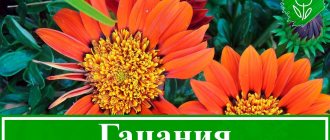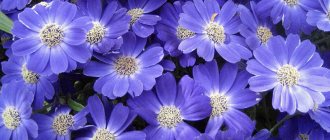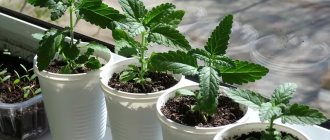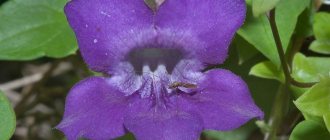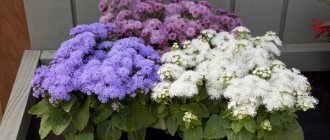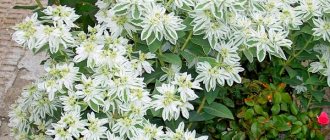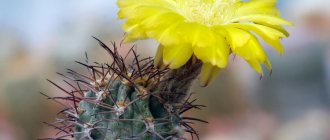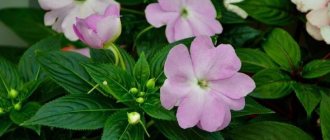Large-flowered flax (Linum grandiflorum) Charm Rubrum
Large-flowered flax is an unpretentious annual with small narrow foliage and airy, loose inflorescences consisting of flowers up to 4-5 cm in diameter. Plants rarely grow above 50 cm in height and 15-22 cm in width. The stems are graceful, but very strong.
The flowers attract pollinating insects to the garden; in the original species they are red. There is not a wide variety of varieties, but there are blue, white, and salmon varieties. The black eye and blue pollen contrast with the color of the petals.
Flax looks good in clumps or together with other bright annuals - toadflax, nigella, eschscholzia, lavatera, poppies, etc. It is used as part of flowering Moorish lawns, for creating borders and edging the boundaries of areas. This short plant looks great in containers.
The inflorescences make a good cut flower for summer bouquets. The seed plants are cut for dried flowers.
|
|
Large-flowered flax (Linum grandiflorum) is native to Algeria. It grows wild in Southern Europe and North America.
This is an annual herbaceous plant 30-60 cm tall, sometimes more than 1 m. The stem is erect, branched in the upper half, glabrous. The leaves are alternate, dense, sessile, 1.5-2.5 cm long, broadly lanceolate, pointed at the end, entire, with 3 main veins. The color of the leaves is green, with a slight bluish tint. The flowers are bright red to purple, regular, five-membered, arranged in few-flowered corymbose inflorescences on pedicels 4-5 mm long, with elongated fruits. Sepals are free, 7 mm long (increase with fruit), ovoid, pointed, serrated and ciliated along the edge. Petals are free, obovate, up to 2 cm long. There are 5 stamens, fused at the base, 6-8 mm long. There are 5 pistils, fused halfway up from the base, with club-shaped stigmas. The fruits are almost spherical five-locular dry capsules 7-8 mm long, with numerous brown flat seeds 2-4 mm long and 0.5-1 mm wide. 1 g contains 250-300 seeds.
The flowers open only in the sun.
Large-flowered flax: description
This is an annual plant with decorative flowers, belonging to the genus Flax from the Flax family. It reaches a height of up to 110 cm, but most often the growth is limited to 30-60 cm. The stem of flax is erect and branched. The leaves are sessile, alternate in arrangement, lanceolate in shape with pointed tips. Bright flowers form an inflorescence corymb, which has a fairly loose structure. The natural habitat is the northwestern part of the African continent (Algeria). Flax was introduced into culture in 1820, and since then it has been actively cultivated as an annual.
Composition and beneficial properties
Flaxseeds contain proteins, fats, gluten and fiber.
100 grams of flaxseed contains:
- fat - 41 g;
- carbohydrates - 28 g;
- proteins - 20 g;
- calorie content - 450 kcal.
Flax seeds contain biologically valuable polyunsaturated fatty acids Omega-3, Omega-6, Omega-9. Acids are necessary for intracellular metabolism and are essential, that is, the human body does not produce them, but receives them from the outside. If we talk about the effect flax seeds have on humans, the benefit for the body of this plant lies in the almost perfect balance between different types of fatty acids.
Flaxseeds contain alpha-linolenic acid (ALA), a polyunsaturated fatty acid that is different from Omega acids. ALA is part of the structure of cell membranes and is necessary for the normal development and functioning of the brain. The acid has a powerful anti-stress effect and increases the recovery capabilities of the cardiovascular system.
Flax contains high molecular weight carbohydrates - polysaccharides. Due to the presence of complex carbohydrates, the seeds, when soaked in water, release colorless and odorless mucus. Mucus has antimicrobial and enveloping properties and is used in gastroenterology in the treatment of inflammatory processes of the stomach and esophagus. For bacterial lesions of the skin and mucous membranes, burns of varying degrees, treatment with a decoction of seeds is an effective aseptic remedy.
Flax is a source of insoluble and soluble fiber, consisting of microfibers from seed coats. Fiber is not digested by the body's food enzymes, but is processed by beneficial intestinal microflora. Fiber has an anti-cancer effect, helps cleanse the body of waste products, and reduces appetite.
The seed coat contains ligans, so they are present in small quantities in flaxseed oil. They are antioxidants, have antimicrobial and antiviral effects, and are used as an antitumor agent.
Flax seeds are distinguished by the presence of large amounts of vitamin F, A and E. Vitamin F is not produced by the human body and can only be obtained from external sources. The combination of vitamins has a strong antioxidant and rejuvenating effect on the skin. Therefore, flax seeds and oil are actively used in cosmetology.
Nutrients are chemical substances that are necessary for the functioning of the body. Flax seeds - the benefits for the body are due to the presence of useful substances in them:
- Potassium. The element plays an important role in the functioning of the heart muscle and maintaining the water-alkaline balance of the body. Flax contains 7 times more potassium than bananas.
- Selena. The chemical element cleanses the body of toxins, has an antitumor effect, has a positive effect on vision, and increases the activity of the brain and central nervous system.
- Lecithin. The substance is found in the sheaths of nerve fibers. The presence of lecithin in the body prevents the development of diseases of the nervous system, in particular memory loss.
Grandiflora flax: cultivation
From small seeds, if desired, you can grow a beautiful perennial plant. Flax has an unpretentious character, is resistant to cold, and tolerates even mild frosts. It is preferable to choose sunny, well-lit areas for it. It will grow in any poor garden soil, but preferably without stagnant moisture. In Russia with cold climatic conditions, we recommend choosing large-flowered flax. Growing from seeds is very simple. Germination is almost 100%, and the plant spreads all the way to the taiga zone.
Before planting, the area must be dug up; it is recommended to add humus or compost (3-4 kg per 1 square meter). And also a tablespoon of superphosphate and potassium sulfate. Then mix everything thoroughly and level it with a rake. It is best to water the soil well and leave it for a couple of days, and only then start planting. This can be done in two ways: seedlings or directly into the ground. Choose the one that suits you best.
Growing areas in Russia
The high requirements of flax for soil, humidity and climate impose great restrictions on the cultivation of this crop. The best conditions for planting this plant are in the temperate climate zone. Fiber flax in Russia is sown in the north of the Central region and the south of the North-West.
Cultivation of land and production of crops is carried out in the Urals and Western Siberia.
Flax is grown only in those regions of the Russian Federation where precipitation levels are high and large rivers are located nearby, which can be used for irrigation. The largest areas of flax crops are located in the Smolensk and Tver regions. In addition, the volume of culture is rapidly increasing in the Tomsk and Novosibirsk regions, as well as in the Altai Territory.
Flax (red) large-flowered growing from seeds to seedlings
It is recommended to sow in mid-April, as the plant develops quite quickly. Use light soil that is permeable to air and moisture. Pour it into small boxes in an even layer of 5-8 cm and moisten with a spray bottle. Do not bury the seeds, but carefully scatter them over the surface, sprinkle a 1 cm layer of soil on top. It is best to make a small greenhouse and cover the box with polyethylene. Be careful with waterlogging - this is what grandiflora flax does not like. Growing from seeds (photo) is a fairly quick process; seedlings will appear in 7-10 days. As soon as the seedlings have the first pair of true leaves, they should be planted in separate pots with a diameter of about 7 cm and the same depth. Flax has a strong tap root system, so we recommend not delaying planting. The further you go, the more difficult it will be to separate the plants from each other without damaging them.
How to propagate flax
The crop is propagated by seeds in spring, summer and autumn using the technology indicated above. They can also be sown in containers for seedlings. Typically, flax is not replanted from containers because it is ineffective. The containers become a permanent place of life for the perennial; they are taken outside in warm weather to decorate the corners of buildings, gazebos, and recreation areas.
Bushes older than 2 years can be carefully divided into several parts in April or August. Then plant the cuttings, without damaging the root system, in a new permanent place. A distance of at least 20 cm is left between new bushes. At first, planting is slightly shaded from direct ultraviolet radiation, the soil under them is moistened, and the soil is weeded.
Sowing seeds in the ground
This method also has a right to exist and is simple. You can sow seeds in early spring (April-May) or late autumn, which is called before winter. Prepare the soil in advance using the method already mentioned above. Then make neat grooves at a distance of 10-15 cm, 4-5 cm deep. Spray them thoroughly with water. Do not press the seeds, but just spread them out in an even layer and sprinkle a small amount of soil on top. When seedlings appear, they must be thinned out, leaving a distance between plants of 5-8 cm.
Perennial flax species
More often than other species grown
Flax of Narbonne, Linum narbonense
A perennial plant, about 30 cm tall with thin, graceful, slightly twisted shoots. The flowers are sky blue, 2.0-2.5 cm in diameter, collected in few-flowered inflorescences on the tops of leafy stems. Blooms in June–July.
Flowering flax of Narbonne
Alpine flax, Linum alpinum
Homeland - limestone rocks in the Alps.
Taproot perennial 40 cm high. Blooms in May–June, seeds in June–July. Propagated by seeds.
Perennial flax, Linum perenne
Homeland - steppes, spruce deposits in Europe, Western Siberia.
Taproot perennial 20-80 cm high. Blooms in June-July with blue flowers, seeds in July-August. Propagated by seeds, self-sowing is possible.
Flowering and fruiting of perennial flax
Bell flax, Linum campanulatum
Perennial plant with yellow flowers.
Yellow flax, Linum flavum
A perennial plant up to 40 cm high. It blooms from July to September with large yellow flowers, up to 2 cm in diameter.
Yellow flax flowering
Caring for perennial flax species
Blue and blue types of ice need open sunny areas with light, fertile soils. Species with yellow flowers can grow in light shade.
They cannot tolerate stagnant moisture.
Perennial flax species are propagated by seeds (sowing before winter or spring) and by dividing the bush (in spring). Seedlings bloom in the second year. It is necessary to replant flax every 4-5 years.
Basic rules for caring for flax
If you want, as they say, to plant a plant and forget it, then choose large-flowered flax (Rubrum). Growing from seeds with seedlings or directly in the ground will not cause any difficulties, and care is even easier.
- Choose light soils without stagnant moisture and cold drafts.
- The plant is heat tolerant, so additional watering will only be required in extremely dry summers.
- During the season, fertilize 2-3 times with complex mineral fertilizers, and the plant will delight you with lush flowering.
- Flowerbeds where flax grows need to be weeded, like any other.
- After rain and watering, it is advisable to loosen the soil so that a crust does not form, especially on heavy soils.
Where is it used?
Fiber, seed and oil are obtained from flax. The seeds contain about 48% oily substance. It is rich in glycerides, oleic, palmitic, linoleic, and stearic acids.
The scope of application of the plant is unusually wide:
- technical seed oil is a very valuable raw material, and the cake is used as protein-rich feed for livestock;
- the stems are used to make premium paper;
- linseed oil has the property of drying quickly, so it is often added to nail polishes and some building materials, including thermal insulation;
- since it is a natural hypoallergenic product, it is often used in cosmetology and soap making;
- The purpose of sowing flax in rural areas is to obtain highly nutritious feed, for example, meal or maca.
Despite modern production of synthetic fabrics and artificial resins, the question of how to grow flax remains relevant. This is explained by the fact that flax fiber and oil are still in demand in many industries.
Linseed oil
Food during fasting days and periods in Rus' could not do without flaxseed oil. Beating butter was a kind of ritual, something festive and entertaining. Before this, it was necessary to dry the flaxseed, grind it in a mill or manually in a mortar. Then the seed was sifted through sieves, and the remains were crushed again. The crushed mass was placed in pots and heated in ovens.
Hot, it was wrapped in thick canvas and placed in a log between two wooden dies. These dies were compressed using wedges. It was necessary to hit the wedges almost with a sledgehammer. Dishes were placed under the deck. With each blow, the moment approached when the first drop of thick amber oil would hit the pan.
Having knocked out, or rather squeezed out, the oil, they took out the flattened bag and inserted a fresh, hot one into the block. Flaxseed and hemp oil were extracted in Rus', apparently in very large quantities, since it was used not only for food, but also for the production of drying oil.
And today they continue to make drying oil from linseed oil, as well as varnishes, linoleum, oil paints... It is eaten and used in folk medicine - linseed oil contains a lot of polyunsaturated fatty acids and phytoestrogens, which are good for health.
Use in landscape design
Since the plant is very unpretentious, you can find many places where fiber flax is grown. This is all the more pleasant since perennial varieties are extremely popular among flower growers and landscape designers.
They are recommended for use in most garden compositions, for example, rock gardens, flower beds, mixborders, rockeries and flower borders.
As a rule, flax is planted together with plants that are tolerant of dry weather and prefer sunny, open areas. When planting perennial varieties on a Moorish lawn, flax exhibits excellent growth and flowering performance. For a harmonious combination, it is recommended to combine it with daisies, marigolds, clover, bells and cornflowers.
Perennial varieties of blue and dark blue colors are not at all whimsical, grow well, and do not require care. That is why they deserve special attention from gardeners. A wide palette of colors allows you to create colorful compositions, and decorative species will enliven any flower bed.
Eating
The seeds of this plant should be consumed because they are very healthy and replenish the lack of many vitamins in the body. Both the grains themselves and the oil from them have a nutty flavor. You can use a coffee grinder to grind them into flour and mix them with regular baked goods, and also add them to any dishes as a seasoning. For a positive effect, 2-3 spoons will be enough. At room temperature, the ground mass will be stored for two weeks, in the refrigerator - about two months.
Ready-made flax seed porridges are very popular and are sold in any store. They retain all their beneficial properties; the main thing is to make sure when purchasing that the expiration date has not expired and that the packaging is sealed.
Do not consume more than 2 tablespoons of raw seed per day because it contains large amounts of cyanide. When heated, it is destroyed, so after heat treatment you can consume flax in unlimited quantities, but it is important not to forget about its laxative effect. It is advisable to store all products containing flax (including oil) in the refrigerator, because they quickly become unusable at temperatures above zero.
Fabric making
Linen fabric has been valued for a long time. The process of obtaining it is not so technically complex as it is labor-intensive. There are usually 6 stages:
Straw is made from the plant using special equipment.
- The raw materials are spread out in the fields for 15-20 days so that they soak in natural moisture.
- They are collected, then dried, crushed and crushed.
- By carding, a strip is obtained, from which a thin twisted thread is made - a roving.
- Fabric is woven on looms.
- They are bleached and dyed and sent for further processing (sewing products).
The fabric varies in type (twill, openwork, jacquard, large-patterned or fine-patterned, linen), thickness and purpose. Napkins, tablecloths, linen, clothing, and thin scarves are made from it. It is even used for technical purposes, for example, for the manufacture of fire hoses: the material is not afraid of constant contact with moisture, on the contrary, it becomes more durable when wet.
The fabric is smooth and has a matte shine. The interweaving of threads is visible to the naked eye. Undyed canvas in noble shades of gray, brown or ivory, things made from it look elegant and tasteful.
This material is very good in hot weather: the body temperature of a person wearing linen clothes is 3-4 degrees lower than that of those dressed in synthetics. In cold weather, this material perfectly accumulates heat. It is also environmentally friendly, breathable, wear-resistant and does not require complex maintenance:
Undyed fabric can be washed in a machine at a temperature of no more than 90 degrees, it is allowed to boil. Painted items are washed at 40-60 degrees.
- Do not use powders and gels with aggressive components, as well as bleaches. It is recommended to use special detergents for washing linen; they help soften the hard fabric.
- You need to dry it flattened, because the fabrics are very difficult to smooth out. Iron at a maximum of 200 degrees; for better results, you can use the steam function.
- Due to the fact that the fabric absorbs odors well, it is recommended to store it in fabric or paper clothing bags, airing it periodically.
Watch this video on YouTube
Its significant disadvantages include wrinkleability, rigidity and high cost.
Application in cosmetology
Cosmetologists widely use flaxseed to create face masks. Masks are effective in combating wrinkles, acne, dry skin, peeling and inflammatory processes of the epidermis. Medicinal components in the formula of linen masks:
- Phylloquinone. Has a whitening effect and helps remove age spots.
- Niacin. Increases the tone of the epidermis, removes shallow wrinkles.
- Thiamine. Has a rejuvenating effect.
- Folic acid. It has an anti-inflammatory effect, fights itching and pain.
- Choline. Soothes sensitive, irritated skin.
- Alpha-linoleic acid. Promotes healing of the epidermis.
Film cosmetics are created using flaxseed. The essence of its action is that after washing off the mask, the action of the components continues and the accumulation effect remains. The skin becomes soft, wrinkles are smoothed out, and a pronounced lifting effect is maintained for a long time. With acne, a positive effect is achieved by increasing the level of metabolism in skin cells. Flaxseeds combine well with other elements used in cosmetology, which allows you to create multifunctional products. In addition, they have a positive effect on hair:
- fight inflammatory processes of the scalp;
- the enveloping effect helps to cope with split ends and brittle hair;
- makes hair smooth and dense;
- enhance hair growth;
- Give hair a brilliant and iridescent shine.
It is easy to prepare a nourishing infusion for hair at home. It is enough to pour the seeds with hot water in the proportion: 1 tablespoon of seeds per 1 liter of boiling water, leave for about 3 hours, strain and rinse your hair after washing. The hair mask is a mucous substance obtained from flaxseed decoction. Flax is also used internally to cleanse the body of toxins, which has a positive effect on the epidermis, giving the skin and hair a healthy, well-groomed appearance.
What other “lazy” plants can be planted in the garden?
There is not always time to care for the garden and flower beds, but everyone wants to have their own fragrant corner on the site. Someone will say that this does not happen, and any plant requires attention. Of course, this is true, but the degree of care and its thoroughness differ. If you rarely visit the dacha, then not only large-flowered flax will suit you. Growing some other species from seeds will also come in handy. Pay attention to the openwork gypsophila. The perennial plant will cover the ground with an even carpet. You can also use an annual analogue - graceful gypsophila, it grows quickly and blooms luxuriantly.
Our traditional cornflower is simple and charming at the same time. Now many varieties have been bred not only with blue coloring, but also white, pink, and purple. In addition, the plant will delight you with a double wave of flowering - June and September.
We recommend choosing fragrant iberis or matthiola, toadflax, alyssum, which weaves everything into an even canvas, calendula (not only pleasant, but also useful), nasturtium for both horizontal and vertical gardening, and morning glory.
If you need an easy-to-care, but spectacular and unusual plant, look to the bright and cheerful large-flowered flax. Growing from seeds at home will help you get high-quality seedlings and plants that are stronger by the time they are planted in the ground.
Perennial large-flowered flax - main varieties
Not a single picture can convey what a flax field actually looks like—light filters are still able to convey the color, but the sensations that arise in the blood and ancestral memory are impossible. And it doesn’t matter that the crop was planted not for viewing, but for industrial or technical purposes (curly - for oil production, fiber will be extracted from longhorn) - its beauty does not diminish from this.
Despite the nuances of the constitution of the two natural representatives of the genus Línum - the longhorn has a lower degree of branching of the inflorescence, greater slenderness and height of the stem, the curly is characterized by more significant branching of the inflorescence and squat growth, the structure of the flower is the same.
It's always strictly 5:
- separate broad-lobed or rounded petals;
- stamens fused at the bases;
- thread-like pistils with linear stigmas and egg-shaped whole ovaries;
- free pointed sepals (also ovoid), finely ciliated, with a finely toothed edge.
An important feature is the total number of stamens - in addition to the five usual ones of normal structure, there are 5 more rudimentary (underdeveloped), having the form of threads or teeth, located opposite the petals.
The capsule (the fruit formed from the ovary) also always has 5 nests - each with 2 half-nests with one seed in each.
A – general view; B – longitudinal section of a flower; B – flower without perianth; G – fruit; D - flower diagram: 1 - calyx, 2 - corolla, 3 - stamen, 4 - pistil, 5 - ovule, 6 - receptacle, 7 - peduncle, 8 - staminode, 9 - connected bases of the stamen filaments.
The flowers of large-flowered wild flax do not differ in structure from the flowers of cultivated crops - only in their bright red color and large corolla diameter with petals two centimeters in length.
Only a specialist can distinguish between seeds of one type or another, but a simple test helps to understand whether you are really dealing with flaxseeds - no other seeds put in the mouth give such a quick and powerful mucus.
Moving on to the description of decorative varieties, it is worth noting that further we are talking exclusively about large-flowered and perennial flax (in contrast to the wild annual ancestor, which blooms in Algeria throughout April and May).
The range of garden flax colors includes almost all zones of the light spectrum - from dazzling white to almost lilac (light tone), which, when planted simultaneously in a flower bed, allows you to create interesting color effects, especially with differences in height of the main crop and “attracted” neighboring plants.
Of the varieties with white-colored corollas, the most famous are:
- Childhood;
- Albatross;
- Diamond.
If the first on the list shines with a boiling white, undistorted “light”, then the second belongs to the so-called “star” forms, the third has a petal texture similar to satin, the length of the petals reaches 2 cm.
Linum suffruticosum
This group also includes a variety called Bright eyes - with a center the color of red ink.
Linum grandiflorum, 'Bright Eyes'
A group of shades close to red allows you to choose:
- Illusions, with a fierce red corolla of a silky texture with a small eye of a darker color;
- Mars, with a rich carmine color and an “eye” of two interchangeable colors;
- Blush, bright pink color, giving a smooth transition into a slightly darker eye.
Photos of red varieties:
The following varieties can also be considered colors close to pink:
- Boogie-Woogie - salmon general background, sharply changing to cherry in the center;
- Aurora - with apricot petals;
- Zorepad (Starfall) - with a star-shaped corolla and a wine-red “eye” in the center.
Zorepad
The large-flowered, up to 4 cm in diameter, form of flax Rubrum (literal translation “purple”), with a center cut off from the general field by a star-shaped spot of black strokes, is annual.
Rubrum
Just as the solar spectrum ends with colors ranging from blue to violet, the following group of varieties should be arranged in the same order:
- Celestial Azure is truly a sky blue tone with a pure white color;
- Seliger is a variety of open blue color, with powerful shields of inflorescences, but not very large flowers;
- Blue Silk - with a two-centimeter diameter corolla, distinguished by an even greater depth of blue tone with silky tints of color, very noticeable when the flowers sway in the wind;
- Sadko - the color of the corolla is lilac, with darker-colored veins showing through.
Photo of blue linen:
If you need to create a composition of drooping plants to create a yellow background, you can resort to planting alpine flax (L. alpinum) with creeping stems, as well as:
- bell-shaped (L. campanulatum) - yellow-flowered with oblong-shaped leaves;
- capitate (L. capitatum) - with a golden-yellow tone of corollas and elongated leaves.
Photos of yellow varieties:
There are also Compactum, which fully lives up to its name, and a wild species with naturally yellow flowers, which is called yellow (L. flavum).
Linum Flavum Compactum
In total, nature has endowed humans with approximately two hundred species of this crop, among which there are varieties with any color of flowers - from white in laxative flax (L. catharticum) to lilac (almost purple) in the species of coarse flax (L. hirsutum).
Linum hirsutum
Therefore, if you live in harsh climatic conditions or adhere to the doctrine of naturalness, flower species can be sown on summer flax grown from seeds collected in the wild.
Decorative linen in landscape design
Blooming throughout the summer with bright flowers, flax is an important component of the Moorish lawn. Planted in the company of cornflowers, daisies, bluebells, poppies, and cereals, flax will complement a flower garden in a natural or rustic style.
Flax is good when planted near large plants with dark textured foliage. Perennial low-growing flax is planted on an alpine hill, combined with cloves and bells, cereals; along the paths, in the foreground are flower beds. You should not combine linen with exquisite aristocratic flowers - roses, lilies, a wildflower is too simple for such a neighborhood.
Plant in landscape design
Brief description of the genus
There are about 200 species in the flax genus, among which the most interesting for a gardener are low-growing compact bushes up to half a meter high, most of them perennials. Flowers can be of various sizes, from small to large, and the color of the corollas is blue, red-pink and white. The shoots are thin, but very strong, thanks to which the plant retains its shape even in unfavorable weather conditions.
Flax is naturally widespread in Africa and North America and is found in some places in Europe and Asia. In the conditions of the Middle Zone, it is successfully cultivated by flower growers, because flax perceives the conditions of a temperate climate as comfortable.
Photo of the plant
The most common photos of flax during the flowering period. Most varieties of this plant produce blue flowers. Photos of flax with white and purple flowers are less common. It is difficult to identify the plant after the fruits have formed and dried in the photo, because it looks like brown stems at the top, in which there are dry capsules.
